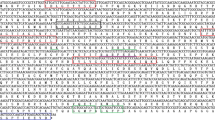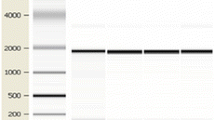Abstract
Ticks and tick-borne-diseases have serious public health implications, and screening feasible protein candidates for vaccines development is identified to be an effective alternative to control of tick infestations. In current study, we focused on cloning the full-length gene encoding a heat shock cognate protein 70 (Hsc70), a molecular chaperone of critical functional roles belonging to heat shock protein 70 (HSP70) family, in salivary glands of Haemaphysalis flava, namely Hf-Hsc70, and analyzing the expression of Hf-Hsc70 in different life phases, organs and ambient temperatures. Rapid amplification of cDNA ends (RACE) was performed to amplify the 5′ and 3′ ends of Hf-Hsc70. The expression profiles of Hf-Hsc70 were studied by semi-quantitative real-time PCR (RT-PCR). The full-length of Hf-Hsc70 was 2363 bp, and contained an ORF of 1965 bp encoding a protein of 648 amino acids. The expression levels of Hf-Hsc70 at different life phases were in the order of female larvae < female fully engorged nymphs < male adult ticks < female full engorged adult ticks < female half engorged adult ticks. The relative expression of Hf-Hsc70 in salivary glands was steadily higher than that in midguts (p < 0.05) regardless of feeding status. A 3-h of heat stress did not significantly induce the up-regulation of Hf-Hsc70 transcription. These results indicated that Hf-Hsc70 was a constitutive form of HSP70 family, and its expression pattern in different life phases and organs suggested a possible role in blood feeding, which would further make Hsc70 a potential candidate for the development of vaccines against ticks.







Similar content being viewed by others
References
Bairoch A (1991) PROSITE: a dictionary of sites and patterns in proteins. Nucleic Acids Res 19(Suppl):2241
Bausero MA, Gastpar R, Multhoff G, Asea A (2005) Alternative mechanism by which IFN-gamma enhances tumor recognition: active release of heat shock protein 72. J Immunol 175:2900–2912
Bolhassani A, Rafati S (2008) Heat-shock proteins as powerful weapons in vaccine development. Expert Rev Vaccines 7:1185
Daugaard M, Rohde M, Jäättelä M (2007) The heat shock protein 70 family: highly homologous proteins with overlapping and distinct functions. FEBS Lett 581:3702
Delelis-Fanien C, Penrad-Mobayed M, Angelier N (1997) Molecular cloning of a cDNA encoding the amphibian Pleurodeles waltl 70-kDa heat-shock cognate protein. Biochem Bioph Res Co 238:159–164
Duan D, Cheng TY (2016) Determination of the microbial community features of Haemaphysalis flava in different developmental stages by high-throughput sequencing. J Basic Microb 57:302–308
Ishigaki Y, Nakarmura Y, Oikawa Y et al (2012) Observation of live ticks (Haemaphysalis flava) by scanning electron microscopy under high vacuum pressure. PLoS One 7:e32676. doi:10.1371/journal.pone.0032676
Kabani M, Martineau CN (2008) Multiple Hsp70 isoforms in the eukaryotic cytosol: mere redundancy or functional specificity? Curr Genomics 9:338–248
Li XL, Kang Y, Zhang XY, Zhu BL, Fang WH (2012) Identification of a heat shock cognate protein 70 gene in Chinese soft-shell turtle ( Pelodiscus sinensis ) and its expression profiles under thermal stress. J Zhejiang Univ Sci B 13:465–477
Liu L, Cheng TY, Yan F (2016) Expression pattern of subA in different tissues and blood-feeding status in Haemaphysalis flava. Exp Appl Acarol 70:511–512
Lo WY, Liu KF, Liao IC, Song YL (2004) Cloning and molecular characterization of heat shock cognate 70 from tiger shrimp (Penaeus monodon). Cell Stress Chaperones 9:332
Noh Y, Lee YS, Kim HC et al. (2017) Molecular detection of Rickettsia species in ticks collected from the southwestern provinces of the Republic of Korea Parasite Vector 10:20 doi:10.1186/s13071-016-1955-x
Ozawa A, Yamaguchi N, Hayakawa K, Matsuo I, Niizuma K, Ohkido M (1982) [a case of tick bite (Haemaphysalis flava)--consideration of tularemia infection through tick bite] Nihon Hifuka Gakkai Zasshi the Japanese. J Dermatol 92:1415–1421
Paim RM, Araujo RN, Leis M, Sant'anna MR, Gontijo NF, Lazzari CR, Pereira MH (2016) Functional evaluation of heat shock proteins 70 (HSP70/HSC70) on Rhodnius prolixus (Hemiptera, Reduviidae) physiological responses associated with feeding and starvation. Insect Biochem Molec 77:10–20. doi:10.1016/j.ibmb.2016.07.011
Polanowska-Grabowska R, Gear AR (2000) Heat-shock proteins and platelet function. Platelets 11:6–22
Polanowska-Grabowska R, Simon CG Jr, Falchetto R, Shabanowitz J, Hunt DF, Gear AR (1997) Platelet adhesion to collagen under flow causes dissociation of a phosphoprotein complex of heat-shock proteins and protein phosphatase 1. Blood 90:1516–1526
Polla BS (1991) Heat shock proteins in host-parasite interactions. Immunol Today 12:A38–A41
Rensing SA, Maier UG (1994) Phylogenetic analysis of the stress-70 protein family. J Mol Evol 39:80–86
Simoncelli F, Morosi L, Di RI, Pascolini R, Fagotti A (2010) Molecular characterization and expression of a heat-shock cognate 70 (Hsc70) and a heat-shock protein 70 (Hsp70) cDNAs in Rana (Pelophylax) lessonae embryos. Comp Biochem Phys A 156:552–560
Sonoda S, Ashfaq M, Tsumuki H (2006) Cloning and nucleotide sequencing of three heat shock protein genes (hsp90, hsc70, and hsp19.5) from the diamondback moth, Plutella xylostella (L.) and their expression in relation to developmental stage and temperature arch. Insect Biochem 62:80–90
Sungjin K, Kang JG, Suyeon K et al (2010) Prevalence of tick-borne encephalitis virus in ticks from southern Korea. J Vet Sci 11:197–203
Tian Z, Liu G, Zhang L et al (2011) Identification of the heat shock protein 70 (HLHsp70) in Haemaphysalis longicornis. Vet Parasitol 181:282
Wang H, Dong SZ, Li K, Hu C, Ye GY (2008) A heat shock cognate 70 gene in the endoparasitoid, Pteromalus puparum, and its expression in relation to thermal stress. BMB Rep 41:388
Wang TT, Wang N, Liao XL, Meng L, Liu Y, Chen SL (2013) Cloning, molecular characterization and expression analysis of heat shock cognate 70 (Hsc70) cDNA from turbot ( Scophthalmus maximus ). Fish Physiol Biochem 39:1377–1386
Wu X, Tan J, Cai M, Liu X (2014) Molecular cloning, characterization, and expression analysis of a heat shock protein (HSP) 70 gene from. Paphia undulata Gene 543:275–285
Xu XL, Cheng TY, Yang H, Liao ZH (2015a) De novo assembly and analysis of midgut transcriptome of Haemaphysalis flava and identification of genes involved in blood digestion, feeding and defending from pathogens. Infect Genet Evol 38:62–72
Xu XL, Cheng TY, Yang H, Yan F, Yang Y (2015b) De novo sequencing, assembly and analysis of salivary gland transcriptome of Haemaphysalis flava and identification of sialoprotein genes. Infect Genet Evol 32:135–142
Xu XL, Cheng TY, Yang H (2016) Enolase, a plasminogen receptor isolated from salivary gland transcriptome of the ixodid tick Haemaphysalis flava. Parasitol Res 115:1955–1964
Yan F, Cheng TY (2015) Morphological and molecular identification of Haemaphysalis flava. Chinese J Vet Sci 35:912–916
Acknowledgments
This research was supported financially by a grant from the National Natural Science Foundation of China (No. 31372431) and a talented faculty fund of Hunan Agricultural University (No. 15YJ05).
Author information
Authors and Affiliations
Corresponding author
Rights and permissions
About this article
Cite this article
Liu, L., Cheng, Ty. & Yang, Y. Cloning and expression pattern of a heat shock cognate protein 70 gene in ticks (Haemaphysalis flava). Parasitol Res 116, 1695–1703 (2017). https://doi.org/10.1007/s00436-017-5444-8
Received:
Accepted:
Published:
Issue Date:
DOI: https://doi.org/10.1007/s00436-017-5444-8




